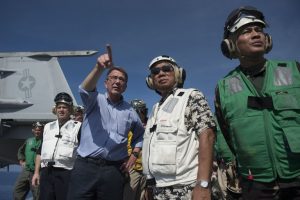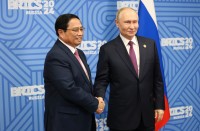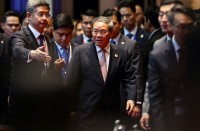
by Laurent Barthelemy
ABOARD the USS John C. Stennis, Undefined (AFP) — US Defense Secretary Ashton Carter visited a warship close to flashpoint waters of the South China Sea on Friday, as Beijing reacted defiantly to an American military build-up in the area.
Carter’s trip to the USS John C. Stennis was the latest effort by the United States to show its commitment to maintaining security in the hotly contested waters, where China has rattled nerves by building artificial islands on islets and reefs claimed by some of its Southeast Asian neighbours.
“It is a message to the region that the US intends to continue to play a role in keeping peace and stability in this region,” Carter told reporters aboard the warship, a nuclear-powered carrier that can carry about 75 planes and helicopters.
Before flying from Manila to visit the ship, Carter emphasised the United States would support the Philippines and other allies as they faced “coercion and intimidation”.
“We will continue to stand up for our safety and freedoms, for those of our friends and allies, and for the values, principles, and rules-based order that has benefited so many for so long,” Carter said at a closing ceremony for annual US-Philippine war games.
The roughly two-hour visit to the Stennis came after Carter announced on Thursday that the United States had launched joint naval patrols with the Philippines in the sea, as he spoke of growing concern about China’s “land reclamation” and “militarisation” of the region.
He also said the United States would deploy hundreds of troops, as well as warplanes, to the Philippines.
China claims nearly all of the strategically vital sea, even waters close to its Southeast Asian neighbours, and has in recent years created the islands in an effort to assert what it insists are its sovereign rights.
The Philippines, Vietnam, Malaysia, Brunei and Taiwan also have overlapping claims to parts of the sea, which is home to some of the world’s most important shipping lanes and is believed to sit atop vast oil reserves.
China has constructed the islands on reefs in the Spratlys archipelago, which are close to the Philippines and Malaysia, as well as airstrips capable of accommodating military aircraft.
China in 2012 also took control of a rich fishing shoal just 220 kilometres (135 miles) from the main Philippine landmass. The shoal is 650 kilometres from China’s nearest major landmass.
Carter visited the Stennis after making a short flight to the carrier from a military base on the southwestern Philippine island of Palawan, which is the closest landmass to the Spratlys.
During his time aboard the ship, Carter saw the launching and landing of F/A 18 “Hornet” fighter jets.
Rear Admiral Ron Boxall, commander of the carrier group with responsibility for the Stennis, said one or two Chinese vessels had been following the carrier but there had been no tensions.
“They have been operating very professionally,” Boxall said.
– Chinese warning –
In Beijing, China reacted defiantly to Thursday’s announcement of the joint patrols and US deployments to the Philippines, with its defence ministry warning the military would protect the nation’s territory.
“US-Philippine joint patrols in the South China Sea promote regional militarisation and undermine regional peace and stability,” said a Chinese defence ministry statement released late Thursday.
“The Chinese military will pay very close attention to related developments, and firmly safeguard China’s territorial sovereignty and maritime rights and interests”.
The 275 US troops and nine aircraft that Carter said would stay in the Philippines following the Balikatan war games are the first major deployments under a bilateral defence pact finalised in January.
The pact allows US forces to rotate soldiers and military hardware through the Philippines, an important part of American efforts to expand its military presence throughout the Asia-Pacific.
US forces will initially have access to five Philippine military bases, including two close to the hotspot areas of the South China Sea.
Philippine Defence Secretary Voltaire Gazmin on Thursday said he hoped the US efforts would “deter uncalled-for action by the Chinese”.
Chinese foreign ministry spokesman Lu Kang on Friday blamed the United States’ deploying extra forces to the Asia-Pacific for any rise in tensions in the region.
lby-kma/mm/fa
© 1994-2016 Agence France-Presse







